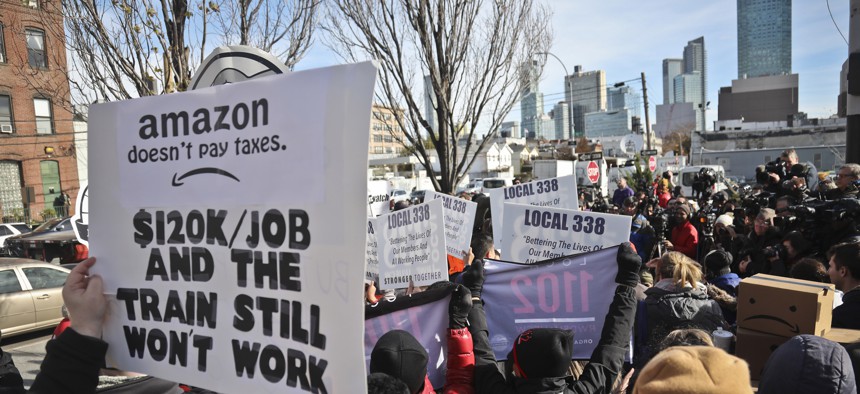Tax Incentives Fail to Spur Broad Economic Growth, Study Finds

In this Nov. 14, 2018, file photo protesters carry anti-Amazon posters during a coalition rally and press conference opposing Amazon headquarters getting subsidies to locate in the New York neighborhood of Long Island City. AP Photo/Bebeto Matthews
Researchers analyzed state and local governments tax incentive spending, finding little evidence that the deals spurred job growth outside the specific industry implicated.
State and local governments are estimated to spend more than $30 billion a year on business tax incentives, but new research finds that these deals do little to promote regional job growth.
The research adds to growing skepticism over the practice of cities and states offering narrow, company-specific tax incentives as a means to attract jobs and economic development.
Looking at incentive deals made between 2002 and 2017 that were worth more than $5 million, researchers from the Princeton University and Columbia Business School found that companies received an average incentive deal worth $178 million and promised an average 1,500 jobs—a cost of about $120,000 per job. But the jobs created were within the industry of the project , and researchers said there was little evidence the incentives stimulated job growth in other industries or had an effect on county-wide employment.
“While we find some evidence of direct employment gains from attracting a firm via incentives, we do not find strong evidence that firm-specific tax incentives increase broader economic growth at the state and local level,” wrote Columbia Business School economist Cailin Slattery and Princeton University economist Owen Zidar in a blog post detailing their findings.
The findings come in the fallout of the Amazon second headquarters campaign, which prompted elected leaders across the country to pitch themselves to the company, offering all kinds of incentives.
But the Amazon wooing also spurred a reexamination of the practice of doling out massive packages to major corporations. While Amazon initially said it would split the new headquarters between suburban Virginia and a Queens location in New York City, officials in New York raised questions about the deal, eventually leading to the company backing out.
Prior research has also cast doubt on the efficacy of tax incentives, with one researcher estimating that in at least 75% of cases he reviewed, a company that received a tax incentive would have made the same decision to relocate, reinvest or expand in the same location even without the sweetner from governments. Skepticism of tax breaks for large corporations has led some states to reevaluate or restrict their use. About two-thirds of states now require regular evaluation of the impact of economic development tax incentives.
This latest research could be particularly damaging for companies seeking deals that rely heavily on promises of economic spillover, said Nathan Jensen, a government professor at the University of Texas, Austin.
“The new piece from here is that it is really hard to find these economic development spillovers, so be really cautious of a project that relies on this indirect impact to be successful,” Jensen said.
The new study did not include analysis of the Amazon deal. States that spent the most per capita on business tax incentives include Michigan, West Virginia, New York, Vermont, and New Hampshire.
The researchers advised that more data about tax incentives is needed to fully understand their effects. They urged state and local government leaders “to tighten eligibility and implementation requirements for targeted incentive programs.”
Andrea Noble is a staff correspondent with Route Fifty.
NEXT STORY: Remote Workers Moving to Tulsa? Foundation Doubles Down on Recruitment Efforts





